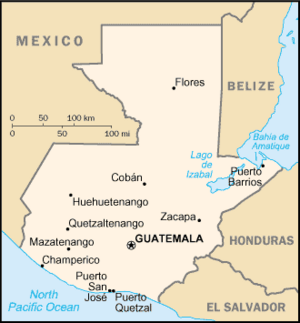| Continent | North America | |
| Subregion | Central America | |
| Geographic coordinates | 15°30′N 90°15′W / 15.500°N 90.250°W | |
| Area - Total - Water | Ranked 106th 108,890 km² approx. 950 km²[1] | |
| Coastline | 400 km | |
| Land boundaries | 1,687 km | |
| Countries bordered | Mexico, 962 km Belize, 266 km El Salvador, 203 km Honduras, 256 km | |
| Maritime claims | 200 nmi (370.4 km; 230.2 mi) | |
| Highest point | Tajumulco volcano, 4,220 m | |
| Lowest point | Pacific Ocean, 0 m | |
| Longest river | Motagua River, 486 km | |
| Largest inland body of water | Lake Izabal 589.6 km² | |
| Land Use - Arable land - Permanent crops - Permanent pastures - Forests and woodlands - Other | 12 % 5 % 24 % 54 % 5 % (1993 est.) | |
| Climate: | Tropical to temperate | |
| Terrain: | plains, mountains | |
| Natural resources | petroleum, nickel, rare woods, fish, wildlife, hydropower | |
| Natural hazards | earthquakes, volcanic eruptions, floodings, landslides | |
| Environmental issues | deforestation, air and water pollution | |
The southern edge of the western highlands is marked by the Sierra Madre, which stretches from the Mexican border south and east, and continues at lower elevations toward El Salvador. The mountain chain is characterized by steep volcanic cones, including Tajumulco Volcano (4,220 m or 13,845 ft, the highest point in the country and Central America. All of Guatemala’s 37 volcanoes (3 of them active: Pacaya, Santiaguito and Fuego), are in this mountain chain, and are abundant in the highlands.
The northern chain of mountains begins near the Mexican border with the Cuchumatanes range, then stretches east through the Chuacús and Chamá sierras, down to the Santa Cruz and Minas sierras, near the Caribbean Sea. The northern and southern mountains are separated by the Motagua valley, where the Motagua river and its tributaries drains from the highlands into the Caribbean being navigable in its lower end, where it forms the boundary with Honduras.
Its climate is hot and humid in the Pacific and Petén Lowlands – more temperate in the highlands, to freezing cold at the high of the Cuchumatanes range, and hot/drier in the easternmost departments.
The rivers are short and shallow in the Pacific vertient, larger and deeper, such as the Polochic which drains in Lake Izabal, Río Dulce, Motagua and Sarstún that forms the boundary with Belize in the Caribbean and the Gulf of Mexico vertient (Usumacinta, which forms the boundary between Chiapas, Mexico and Petén and its tributaries such as La Pasión and San Pedro.
Most of the major cities are located in the Highlands. Major cities are the capital Guatemala City, elevation 1,500 m (Central Highlands), Antigua Guatemala, elevation 1,530 m (Central Highlands), Quetzaltenango elevation 2,350 m (Western Highlands) and Puerto Barrios on the Caribbean coast. The largest lake Lago de Izabal (589.6 km²), is close to the Caribbean coast. Volcán Tajumulco, 4,220 m, the highest point in Central America, is located in the western department of San Marcos.
Guatemala's location on the Caribbean Sea and Pacific Ocean makes it a target for hurricanes, including Hurricane Mitch in 1998 and Hurricane Stan in October 2005, which killed more than 1,500 people. (The damage was not wind related, but caused by flooding and landslides). The last major earthquake was on February 4, 1976, killing more than 23,000 in the Central Highlands (see also: Earthquakes in Guatemala)..


